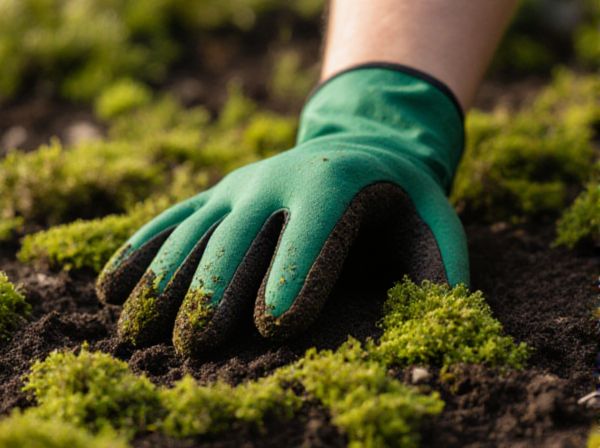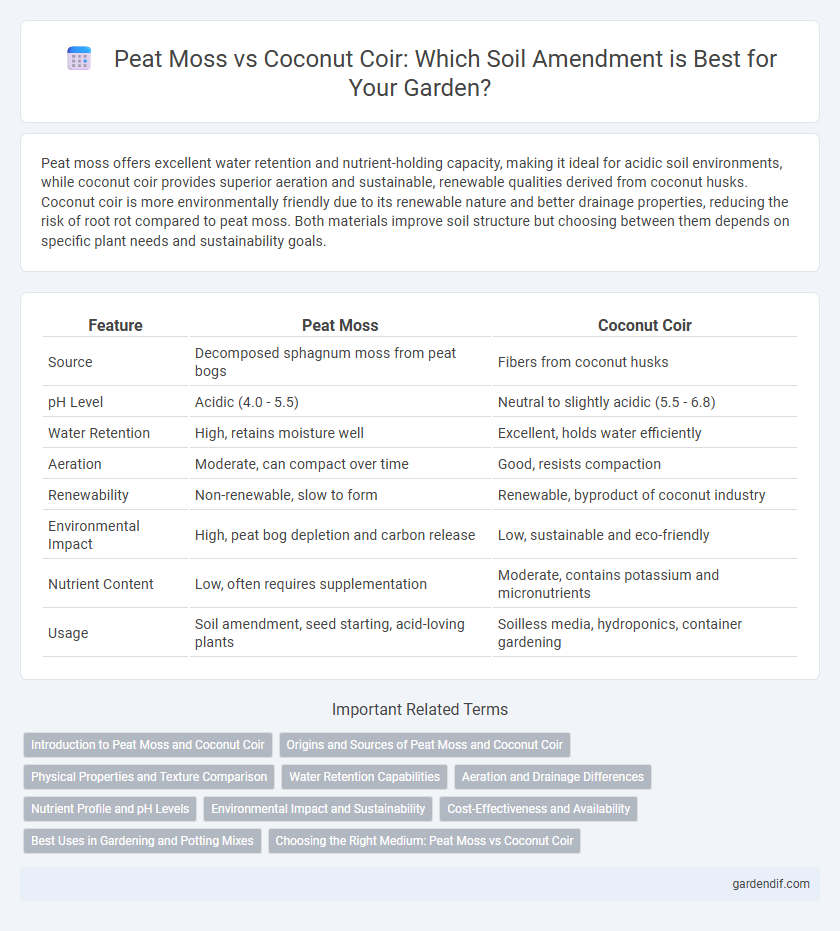
Peat moss vs Coconut coir Illustration
Peat moss offers excellent water retention and nutrient-holding capacity, making it ideal for acidic soil environments, while coconut coir provides superior aeration and sustainable, renewable qualities derived from coconut husks. Coconut coir is more environmentally friendly due to its renewable nature and better drainage properties, reducing the risk of root rot compared to peat moss. Both materials improve soil structure but choosing between them depends on specific plant needs and sustainability goals.
Table of Comparison
| Feature | Peat Moss | Coconut Coir |
|---|---|---|
| Source | Decomposed sphagnum moss from peat bogs | Fibers from coconut husks |
| pH Level | Acidic (4.0 - 5.5) | Neutral to slightly acidic (5.5 - 6.8) |
| Water Retention | High, retains moisture well | Excellent, holds water efficiently |
| Aeration | Moderate, can compact over time | Good, resists compaction |
| Renewability | Non-renewable, slow to form | Renewable, byproduct of coconut industry |
| Environmental Impact | High, peat bog depletion and carbon release | Low, sustainable and eco-friendly |
| Nutrient Content | Low, often requires supplementation | Moderate, contains potassium and micronutrients |
| Usage | Soil amendment, seed starting, acid-loving plants | Soilless media, hydroponics, container gardening |
Introduction to Peat Moss and Coconut Coir
Peat moss, derived from partially decomposed sphagnum moss in peat bogs, is a highly absorbent organic material that improves soil aeration and moisture retention. Coconut coir, made from the fibrous husk of coconuts, offers excellent water retention and promotes root growth with its natural resistance to fungal diseases. Both materials serve as sustainable soil amendments, enhancing soil structure and fertility in gardening and horticulture.
Origins and Sources of Peat Moss and Coconut Coir
Peat moss originates from the partially decomposed remains of sphagnum moss found in water-saturated bogs and wetlands, primarily in northern regions like Canada and Northern Europe. Coconut coir, derived from the fibrous husk of coconut shells, is a renewable byproduct sourced mainly from tropical countries such as India, Sri Lanka, and the Philippines. Both materials serve as organic soil amendments but differ significantly in their natural origins--peat moss from ancient, carbon-rich bogs and coconut coir from sustainable coconut agriculture.
Physical Properties and Texture Comparison
Peat moss exhibits a fine, spongy texture with high water retention and acidic pH, making it ideal for moisture-loving plants. Coconut coir has a coarser, fibrous texture with excellent aeration and neutral to slightly acidic pH, promoting root oxygenation and drainage. Both substrates improve soil structure, but peat moss compacts over time while coconut coir maintains long-term resilience and porosity.
Water Retention Capabilities
Peat moss exhibits superior water retention capabilities, holding up to 20 times its weight in water, making it ideal for moisture-loving plants. Coconut coir retains water efficiently as well, absorbing around 8-9 times its weight, but it drains better and resists compaction over time. Both substrates improve soil aeration and moisture balance, yet peat moss excels in prolonged water retention while coconut coir offers quicker drying and durability.
Aeration and Drainage Differences
Peat moss has a fine texture that retains moisture well but can compact over time, reducing aeration and slowing drainage in soil mixes. Coconut coir features a fibrous structure that promotes superior airflow and faster water drainage, preventing root rot and enhancing oxygen availability. This makes coconut coir a preferred choice for improving soil aeration and preventing waterlogging compared to peat moss.
Nutrient Profile and pH Levels
Peat moss has an acidic pH ranging from 3.5 to 4.5 and is low in nutrients, requiring supplementation for plant growth. Coconut coir maintains a near-neutral pH of 5.5 to 6.8 and contains moderate levels of potassium and trace minerals, enhancing soil fertility. The choice between peat moss and coconut coir depends on the desired pH adjustment and nutrient supplementation in the soil.
Environmental Impact and Sustainability
Peat moss harvesting significantly disrupts fragile bog ecosystems, releasing stored carbon dioxide and contributing to greenhouse gas emissions, whereas coconut coir is a byproduct of coconut processing, making it a more sustainable alternative with lower environmental impact. Peatlands take thousands of years to regenerate, leading to long-term ecological damage, while coconut coir is renewable and biodegradable, promoting circular waste use. Choosing coconut coir supports soil aeration and water retention without depleting vital natural habitats or increasing carbon footprints.
Cost-Effectiveness and Availability
Peat moss offers widespread availability and consistent texture but tends to be more expensive due to its non-renewable nature and environmental regulations limiting harvest. Coconut coir is often more cost-effective, providing a sustainable alternative with ample supply from coconut processing waste, making it popular in regions with coconut agriculture. Availability of coir can vary seasonally and geographically, but its renewable source and competitive pricing make it a preferred choice for budget-conscious gardeners and commercial growers.
Best Uses in Gardening and Potting Mixes
Peat moss excels in retaining moisture and acidity, making it ideal for acid-loving plants like blueberries and azaleas, as well as improving soil structure in garden beds. Coconut coir offers superior aeration and water retention with a neutral pH, making it perfect for seed starting, container gardening, and hydroponics. Both materials enhance potting mixes, but coconut coir provides a more sustainable and renewable alternative to peat moss.
Choosing the Right Medium: Peat Moss vs Coconut Coir
Peat moss offers excellent water retention and acidity for acid-loving plants, but it is a non-renewable resource with environmental concerns, making coconut coir a sustainable alternative rich in lignin and cellulose that provides good aeration and moisture retention. Coconut coir has a neutral pH and decomposes more slowly, improving soil structure and promoting healthy root growth without altering soil acidity as peat moss does. When selecting a growing medium, consider peat moss for acidic, moisture-demanding crops, while coconut coir suits organic gardening and sustainable practices due to its renewable nature and balanced nutrient profile.
Peat moss vs Coconut coir Infographic

 gardendif.com
gardendif.com